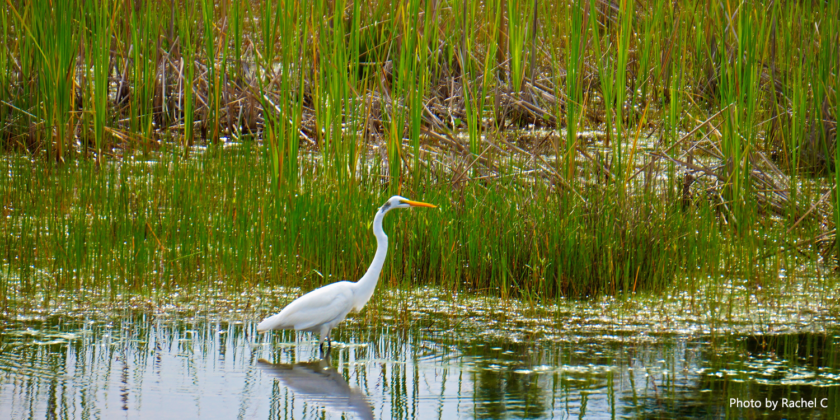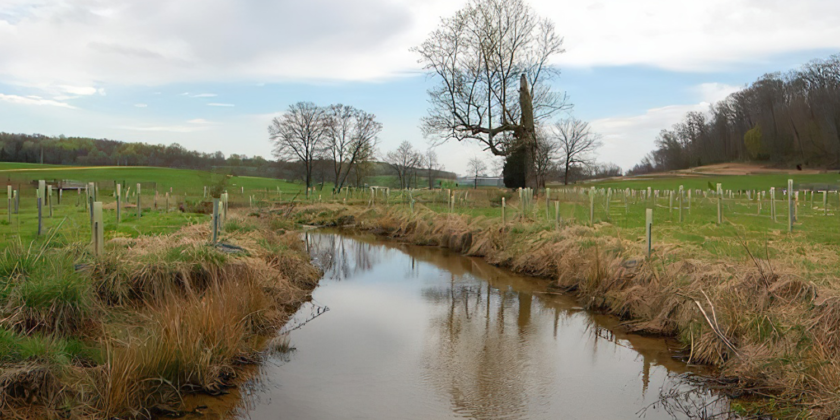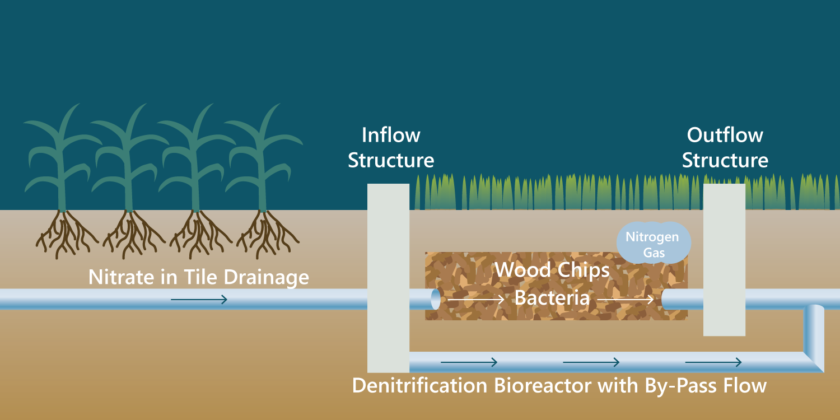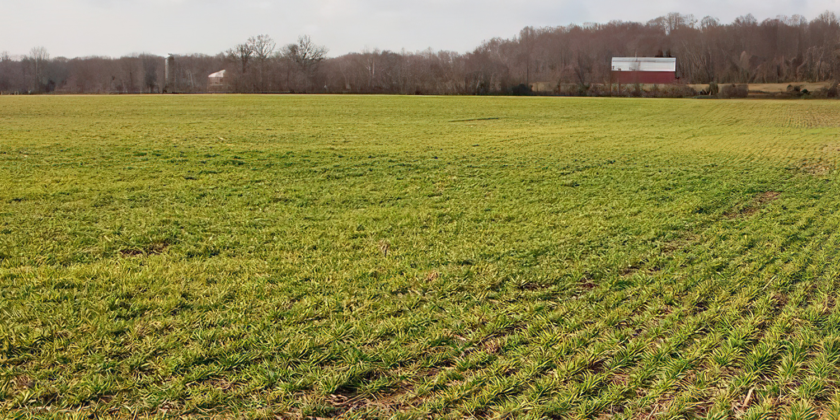Protecting & Restoring Long Island's Peconic Bays

This category includes best management practices (BMPs) that reduce the amount of nitrogen entering groundwater and surface waterbodies from agricultural practices. Agricultural BMPs in this assessment include wetland, grass and forest buffer systems, edge-of-field nitrogen management systems, and agricultural nutrient reduction practice scenarios for which costs and nitrogen load reduction estimates were available, including nutrient management, cover crops, alternative crops and land retirement, conservation cover crop rotation, and controlled-release nitrogen fertilizer (CRNF). There are numerous agricultural practices that can provide cost-effective nitrogen reduction benefits, but given the inherent variability caused by the complexities associated with crop-soil-environment interactions, a detailed evaluation of all practices is beyond the scope of this project. Additionally, practices summarized here focus on factors that impact cost and nitrogen reduction, and due to project limitations do not provide complete characterization of the complexities associated with implementation of these practices. There is considerable crop diversity within the Peconic Estuary watershed and the extent to which implemented BMPs will reduce nitrogen loss to the environment will vary significantly, as nutrient management practices are crop-, soil-, and farm- specific. The high cost of property on Eastern Long Island adds an additional layer of complexity to the ability of a given farm operation to broadly adopt multiple BMPs. This array of conditions means that potential solutions should be assessed on a case-by-case basis.
BMP nitrogen removal estimates and associated cost information are based on the United States Department of Agriculture Natural Resources Conservation Service (USDA-NRCS) National Conservation Practice Standards[1] and the Chesapeake Assessment Scenario Tool (CAST) developed by the Chesapeake Bay Program (2020). CAST was developed based on an extensive review process and relies on adherence to NRCS guidance. However, there are more than 100 crops grow on Long Island and sometimes on an individual farm. This diversity means that nutrient management is not the same everywhere and there is significant variability depending on the crop-soil-environment interactions. Nutrient management practices are farm specific. The Cornell Cooperative Extension of Suffolk County[2] (CCE), the Suffolk County Soil and Water Conservation District[3] (SCSWCD), and local USDA-NRCS personnel provide resources and technical expertise to assist farmers in the development, implementation, and evaluation of cost-effective and environmentally sustainable farming practices.
[1] https://www.nrcs.usda.gov/wps/portal/nrcs/detail/national/technical/?cid=nrcsdev11_001020
[2] http://ccesuffolk.org/agriculture
[3] https://www.suffolkcountyny.gov/departments/soil-and-water-conservation-district

View more information on Wetland Conservation and Restoration >>

View more information on Forest and Grass Buffers >>

View more information on Denitrifying Bioreactors >>

View more information on Agricultural Nutrient Reduction Practice Scenarios>>
Belt, K., P. Groffman, D. Newbold, C. Hession, G. Noe, J. Okay, M. Southerland, G. Speiran, K. Staver, A. Hairston-Strang, D. Well, and D. Wise. Recommendations to the Expert Panel to Reassess Removal Rates for Riparian Forest and Grass Buffers Best Management Practices. Submitted to the Forestry Workgroup, Chesapeake Bay Program. October 2014.
Chesapeake Bay Program, 2017. Cover Crops Practices for Use in Phase 6.0 of the Chesapeake Bay Program Watershed Model. CBP/TRS-310-16.
Chesapeake Bay Program, 2018. Chesapeake Bay Program Quick Reference Guide for Best Management Practices (BMPs): Nonpoint Source BMPs to Reduce Nitrogen, Phosphorus and Sediment Loads to the Chesapeake Bay and its Local Waters. CBP/TRS-323-18. Available at: https://www.dec.ny.gov/docs/water_pdf/cbbmpguide18.pdf.
Chesapeake Bay Program, 2020. Chesapeake Assessment and Scenario Tool (CAST) Version 2019. Chesapeake Bay Program Office. Available at: https://cast.chesapeakebay.net/. Last accessed May 2021.
Craft, C., J. Clough, J. Ehman, S. Joye, R. Park, S. Pennings, H. Guo, and M. Machmuller, 2009. “Forecasting the Effects of Accelerated Sea-Level Rise on Tidal Marsh Ecosystem Services.” Front. Ecol. Environ. 7(2):73–38.
Deborah Aller, 2020. Personal communication with Deborah Aller, Cornell Cooperative Extension of Suffolk County. October 6, 2020.
Jordan, T.E., D.F. Whighman, K. H. Holfockel, M.A. Pittek. 2003. “Nutrient and Sediment Removal by a Restored Wetland Receiving Agricultural Runoff.” J. Environ. Quality, 32(4), 1534-47.
Fixen, P.E. 2020. “A Brief Account of the Genesis of 4R Nutrient Stewardship.” Agronomy Journal, 112(5), 4511– 4518. https://doi.org/10.1002/agj2.20315
Jordan, T.E., D.F. Whighman, K. H. Holfockel, M.A. Pittek. 2003. “Nutrient and Sediment Removal by a Restored Wetland Receiving Agricultural Runoff.” J. Environ. Quality 32(4):1534-47.
Kaplan W., I. Valiela, and J.M. Teal, 1979. “Denitrification in a salt marsh ecosystem.” Limnol. Oceanogr. 24:726–734.
Kovacic, D. A., David, M. B., Gentry, L. E., Starks, K. M., & Cooke, R. A., 2000.. “Effectiveness of Constructed WetlandsWetlandsCW in Reducing Nitrogen and Phosphorus ExportExportRNPE from Agricultural Tile Drainage.ATD.” Journal of Environmental Quality 29(4):1262-1274.
Land, M., W. Graneli, A. Grimvall, C.C. Hoffman, W.J. Mitsch, K.S. Tonderski, and J.T.A. Verhoeven, 2016. “How Effective are Created or Restored Freshwater Wetlands for Nitrogen and Phosphorus Removal? A Systematic Review”.” Environ Evid 5:9.
Liu, G., E.H. Simonne, Y. Li, C.M. Hutchinson, M. Warren, and S. Lands, 2017a. Controlled-Release Fertilizers for Commercial Potato Production in Florida. Document No. HS941. Horticultural Sciences Department, University of Florida/Institute of Food and Agricultural Sciences Extension. Original publication date July 2006. Revised October 2011, August 2014, and October 2017.
Liu, G., L. Zotarelli, Y. Li, D. Dinkins, Q. Wang, and M. Ozores-Hampton.,2017b. Controlled-Release and Slow-Release Fertilizers as Nutrient Management Tools. Document No. HS1255. Horticultural Sciences Department, University of Florida/Institute of Food and Agricultural Sciences Extension.
Mohler, C.L. and S.E. Johnson, 2009. Crop Rotation on Organic Farms: A Planning Manual. Sustainable Agriculture Research and Education (SARE) Program. Natural Resource, Agriculture, and Engineering Service. Cooperative Extension. IV. NRAES 177.
NRCS (Natural Resources Conservation Services), 2012. Natural Resources Conservation Service Conservation Practice Standard Nutrient Management. Code 590. Available at: https://www.nrcs.usda.gov/Internet/FSE_DOCUMENTS/stelprdb1046433.pdf
NRCS, 2015. Natural Resources Conservation Service Conservation Practice Standard Nutrient Management. Code 318. Available at: https://efotg.sc.egov.usda.gov/references/public/NY/nyps328.pdf
NRCS, 2021. Natural Resources Conservation Service Conservation Practice Scenarios – Fiscal Year 2021. Available at: https://www.nrcs.usda.gov/wps/portal/nrcs/detail/national/programs/financial/?cid=nrcseprd1328254
NYS (New York State), 2015. Stormwater Management Design Manual. Updated by New York State Department of Environmental Conservation. January 2015.
Ooi, S.K., A. Barry, B.A. Lawrence, C.S. Elphick, and A.M. Helton, 2020. Changing Salt Marsh Vegetation: Implications for Denitrification. Submitted to Ecological Applications.
Persson, J., N.L.G. Somes, and T.H.F. Wong, 1999. “Hydraulics Efficiency of Constructed Wetlands and Ponds.” Wat. Sci. Tech. 3:291–300.
Phillips, J.D., 1989. “An evaluation of the factors determining the effectiveness of water quality buffer zones.” Journal of Hydrology 110:221–237.
Simpson, T. and S. Weammert, 2009. Developing Best Management Practice Definitions and Effectiveness Estimates for Nitrogen, Phosphorus, and Sediment in the Chesapeake Bay Watershed. Final Report. December 2009.
Suffolk County (Suffolk County, New York), 2016. Agricultural Stewardship Plan. March 2016. Available at: https://www.peconicestuary.org/wp content/uploads/2017/06/ AgriculturalStewardshipPlan.pdf
Suffolk County Department of Planning, 2010. Robinson Duck Farm County Park Habitat Restoration Feasibility Study. June 2010.
Tyndall, J., and T. Bowman, 2016. Iowa Nutrient Reduction Strategy Best Management Practice Cost Overview Series. Nutrient Reduction Strategy Decision Support Tool. Department of Ecology & Natural Resource Management, Iowa State University.
USDA (United States Department of Agriculture), 2017. Healthy, Productive Soils Checklist for Growers. Available at: https://www.nrcs.usda.gov/wps/portal/nrcs/detailfull/national/soils/health/?cid=stelprdb1049236
USEPA (U.S. Environmental Protection Agency), 1999. Preliminary Data Summary of Urban Storm Water Best Management Practices. EPA-821-R-99-012.
USEPA, 2005. Riparian Buffer Width, Vegetative Cover, and Nitrogen Removal Effectiveness: A Review of Current Science and Regulations. EPA/600/R-05/118.
USFWS (United States Fish and Wildlife Service), 2020. 2020 National Coastal Wetland Conservation Grants Project Summaries. Available at: https://www.fws.gov/coastal/coastalgrants/pdfs/2020-Coastal-Wetlands-Grants-Project-Summaries-Final.pdf
USGS (U.S. Geological Survey), 2001. Estimates of Nitrogen Loads Entering Long Island Sound from Ground Water and Streams on Long Island, New York, 1985-1996.
Woltemade, C.J., 2000. “Ability of Restored Wetlands to Reduce Nitrogen and Phosphorus Concentrations in Agricultural Drainage Water.” Journal of Soil and Water Conservation 55(3):303–309.
Sign up for News, Events and Information straight to your inbox.
